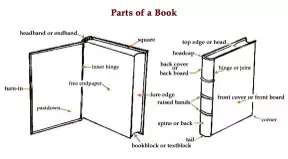
Some time ago I noticed a diagram of pieces of a book pinned up next to a colleague’s desk. She had found it via an online image search and kept it because in our line of work being able to refer to specific pieces of a book can be useful. For example, we may need to refer to a part of a book if we are doing a bit of book repair or if we need to return books, damaged in shipping, to a vendor.
However, looking at this image was a reminder to me that despite working with books for years I had more to learn about the pieces of this ancient technology. After some research, I have come up with a few definitions that, if not all that useful in day-to-day library work, might be fun to drop in conversation at parties if you want to appear “book smart”:
- Endpapers: these are the heavy-stock papers inside the front and back covers of hardcover books. One side of the paper is glued to the cover and the other is “free” or next to the text block (the pages of the book). The endpapers are usually blank but they may include maps, family trees, or intricate designs. Older books often feature gorgeous endpapers.
- Flyleaf or flyleaves: the blank page or pages (leaf or leaves) next to the endpapers at the beginning and end of a book.
- Joint: the point on a hardcover book where the cover connects to the spine. The inside of the joint is the hinge.
- Leaf, or Leaves (plural): in bookbinder-speak, a leaf is a single sheet of paper, or two pages front and back. The front side of the leaf is the recto or obverse while the back is the verso or reverse.
- Raised Bands: these aren’t seen much these days except as a decoration, but years ago the cords used to sew pages together would not be flush with the edges of the pages. The spine cover, applied later in the bookbinding process, ended up with those characteristic horizontal raised bands.
- Spine: we all know that the spine is the edge of the book where the pages are bound together. One note about spines: in many hardcover books, you will see fabric at the top and bottom of the pages inside the spine. This is the headband (top of the book) and tailband (bottom of the book). They help to protect the space between the block of bound pages and the spine.
- Text block: this is the stack of pages that make up a book. The binding may be sewn or glued at one end (the spine) with the board (or book covers) on the outside.
It is amazing how well all these pieces work together. The next time you pick up a book at the library please take a moment to consider how long this format has lasted and how relevant it remains even in our high-tech world.
Public domain image from Wikimedia Commons.
